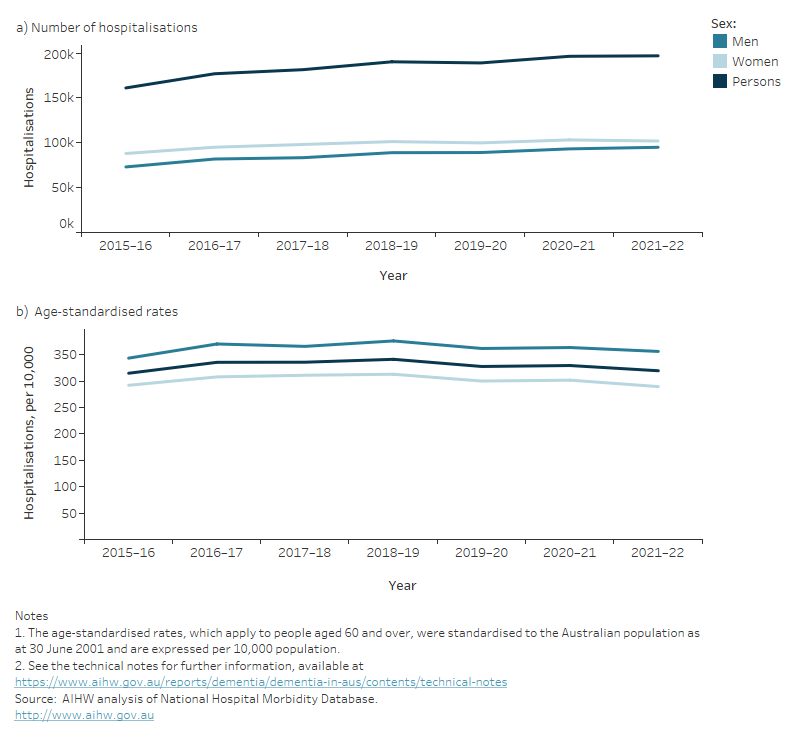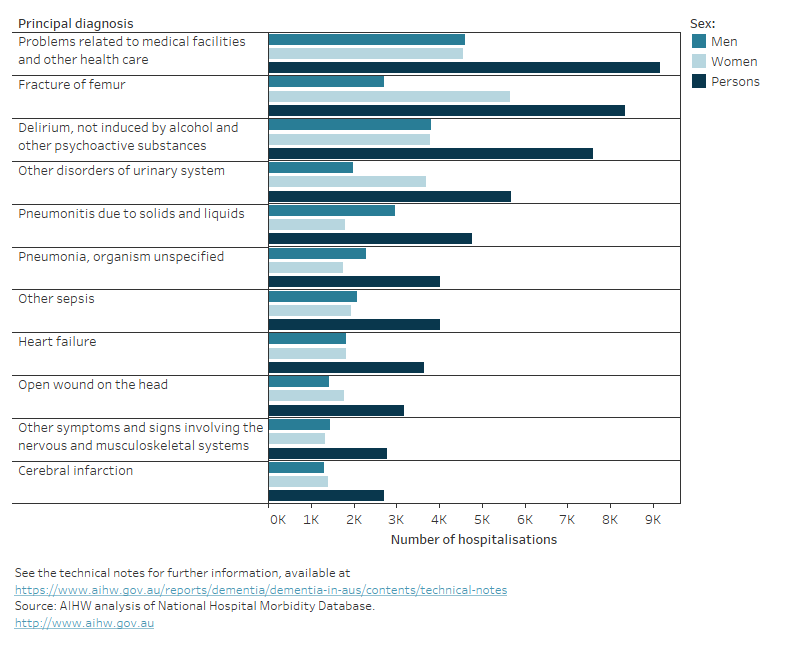Hospitalisations with dementia
On this page
The previous page presented hospitalisations due to dementia (that is, when dementia was recorded as the principal diagnosis), but understanding hospitalisations with dementia provides important insights on the wide-ranging conditions that can lead people living with dementia to use hospital services. Hospitalisations with dementia are hospitalisations where dementia was recorded as a principal diagnosis and/or an additional diagnosis (where dementia impacted the hospitalisations but was not the main reason for admission), or where dementia was recorded as a ‘supplementary code’ (when dementia is identified as a chronic condition that is part of a patient’s current health status).
When accounting for all possible inclusions of dementia codes in a patient record, hospitalisations with dementia are just under 197,000 admissions (95,000 for men and 102,000 for women). This is equivalent to almost 2 out of every 100 hospitalisations in Australia.
Between 2015–16 and 2021–22, there was an increase in the number of hospitalisations (22.2% increase) while the age-standardised rate remained reasonably stable (Figure 9.7). Age-standardised rates are helpful for determining the trend independent of age structures changing over time (Australia’s ageing population) and population growth. The age-standardised rates increased slightly from 2015–16 to 2018–19, then decreased slightly to 2021–22. The age-standardised rate average annual increase was 0.2%.
Figure 9.7: Hospitalisations with dementia between 2015–16 and 2021–22 by sex: (a) number and
(b) age-standardised rate
Figure 9.7 shows two line graphs showing the estimated number and age-standardised rates of hospitalisations with dementia in Australia by sex between 2015–16 and 2021–22. Distinct patterns are explained in the previous paragraph.

Box 9.3: Potential factors impacting hospitalisations with dementia over time
In July 2015, 29 supplementary codes for chronic conditions (including dementia) and a new Australian Coding Standard were implemented in existing classification systems and coding rules for assigning specific codes to diagnoses found in medical records (ACCD 2015). As a result, from July 2015 onwards dementia can be recorded in hospital data using a supplementary code when it does not meet the criteria to be recorded as a principal or additional diagnosis.
It is not yet understood whether the introduction of supplementary codes has impacted recording of chronic conditions as additional diagnoses in hospitals data. It may have resulted in less recording of dementia as an additional diagnosis, especially in cases where dementia did not directly impact the care provided to the patient. The exclusion of supplementary codes may explain the slightly declining rates from 2015–16 to 2021–22 (Figure 9.7).
What were the most common principal diagnoses when dementia was an additional diagnosis?
In 2021–22 there were almost 197,000 hospitalisations where dementia was recorded as an additional or supplementary diagnosis. Examining the most common principal diagnoses recorded for these hospitalisations provides insights on the diverse reasons why people with dementia require hospital services. The most common principal diagnoses were:
- Problems related to medical facilities and other health care, ICD-10-AM codes Z75.0–9 (9,200 hospitalisations or 5.1% of hospitalisations where dementia was an additional diagnosis).
- these hospitalisations are where patients are required to stay in hospital longer to rehabilitate or are waiting to transfer to new accommodation. These hospitalisations may be counted as a separate hospitalisation rather than a continuation of a hospitalisation from an acute episode (such as a fracture)
- Fracture of the femur, ICD-10-AM codes S72.0–9 (8,400 hospitalisations or 4.6%)
- Delirium, not induced by alcohol and other psychoactive substances, ICD-10-AM codes F05.0–9 (7,600 hospitalisations or 4.2% of hospitalisations where dementia was an additional diagnosis)
- Other disorders of urinary system, ICD-10-AM code N39X (5,700 hospitalisations or 3.2%) (Figure 9.8).
Other common principal diagnoses recorded for these hospitalisations included respiratory diseases, cardiovascular diseases and sepsis.
Falls (ICD-10-AM codes W00–W19) accounted for 97% of all hospitalisations due to fractures of the femur, and 95% of hospitalisations due to fractures of the lumbar spine and pelvis, where dementia was an additional diagnosis. Women had twice as many hospitalisations than men for a fracture of the femur and fracture of the lumbar spine and pelvis, with an additional diagnosis of dementia (Table S9.10).
Figure 9.8: Most common principal diagnoses where dementia was an additional diagnosis in 2021–22, by sex
Figure 9.8 shows a bar graph showing the number of hospitalisations for the most common principal diagnoses when dementia was recorded as an additional diagnosis, by sex in 2021–22. Distinct patterns are explained in the previous paragraphs.

ACCD (The Australian Consortium for Classification Development) (2015) Reference to Changes for ICD-10-AM/ACHI/ACS 9th edn, Independent Hospital Pricing Authority, Australian Government, accessed 17 August 2022.


